We knew that Rammellzee deserved an intellect and artist operating on his wavelength to give a fair examination of his work and this exhibition, and very few can rise to the occasion the way that EKG does today for BSA readers. The exhibition is phenomenal in its scholarship and presentation without question thanks to its curators. EKG is naturally equipped to decode and help others appreciate the artist thanks to his exhaustively inquisitive nature, reverence for methods of applied science, brilliant data sequencing ability, and NYC streetwise intellect.
THE RAMM:ΣLL:ZΣΣ EQUATION = AN ALGORITHMIK BIO-HACKED ANTIDOTAL INJECTION INTO THE BODY-POLITIK OF THE DISEASE-CULTURE MATRIX
An article in two parts:
(1) A look at Rammellzee’s life and work.
(2) A review of the RAMMELLZEE: RACING FOR THUNDER exhibition
by ( ( ( ekg ) ) )
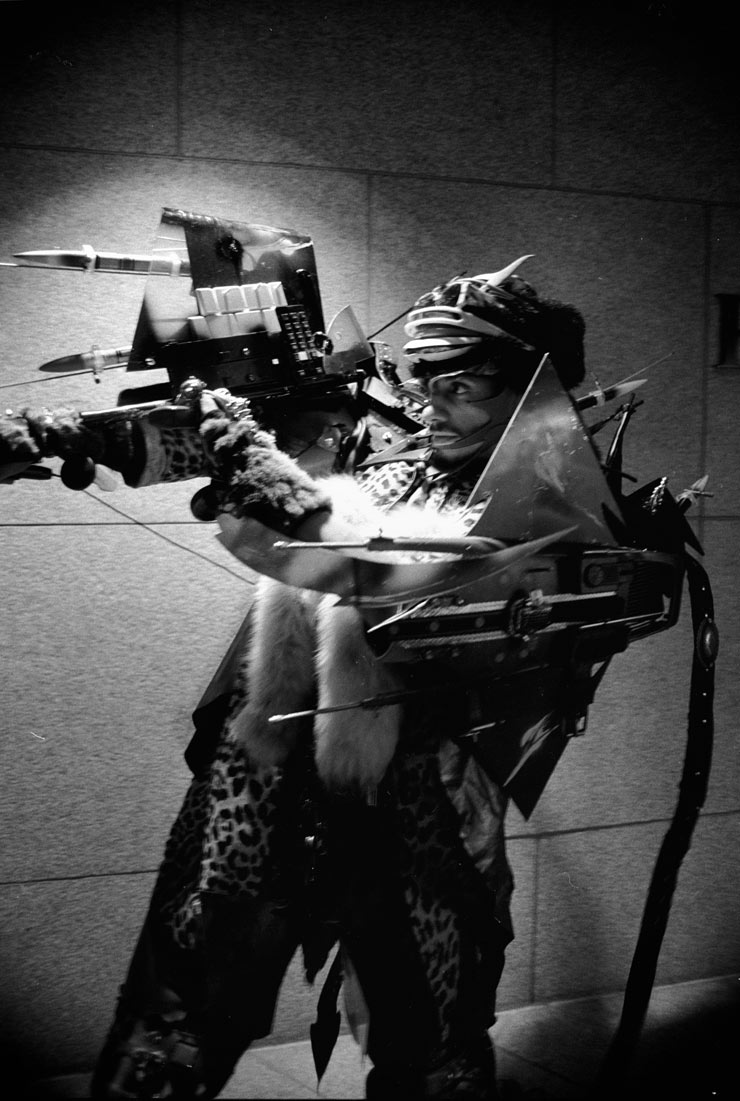
Rammellzee (photo © Brian Williams. Courtesy of Red Bull Arts)
Part 1: The Rammellzee.
By the age of nineteen, a graffiti writer from Far Rockaway, Queens, NYC, had already come to the advanced aesthetic decision to legally abandon his family-bestowed and governmentally-designated name, and knight himself with a self-defined alpha-numeric neologism: THE RAMM:ΣLL:ZΣΣ. With this subversive act of mathe-poetic mutation, the prodigal prodigy ironically utilized the very machinations of power and control to re-code himself as an aesthetic bio-hack manifestation injection challenging the status quo system. Then, for the rest of his life, he steadfastly kept his original designation an absolute secret, thereby proving the seriousness and effectiveness of the manifest destiny of his semiotic transformation into a wraith of rebellion in the Aestherial Semiotosphere.
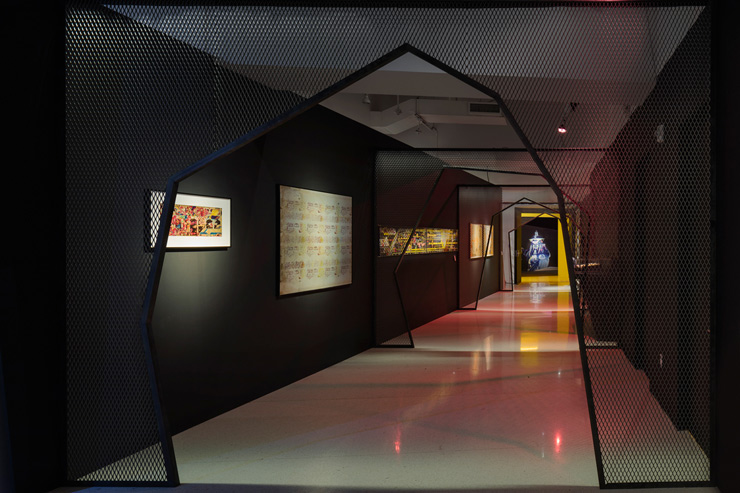
Rammellzee: Racing For Thunder. (photo © Red Bull Arts)
Rammellzee’s self-induced rebirth was the pinnacle of his aesthetic and theoretical development during his teens in the mid-to-late 1970s. Illustrating his natural visual gifts, Rammellzee’s early work was a combination of precise drafting techniques with an expressionistic use of spray paint. Revealing his intellectual depth and writing talents, he formulated a universal aesthetic philosophy called Gothic Futurism, as well as codifying the stylistic elements of Wild Style graffiti into an advanced set of militaristic semiotic forms that he dubbed Ikonoklast Panzerism. Displaying his charismatic leadership qualities, he formed the crew Tag Master Killers, consisting of the other graffiti writers A-One, Delta2, Kool Koor and Toxic, who had the talents to execute his exacting stylistic tenets. Also, due to his relentless social energy as a performer and rapper, he was quickly recognized as a significant presence in not only the graffiti and art communities, but the hip hop subculture as well.
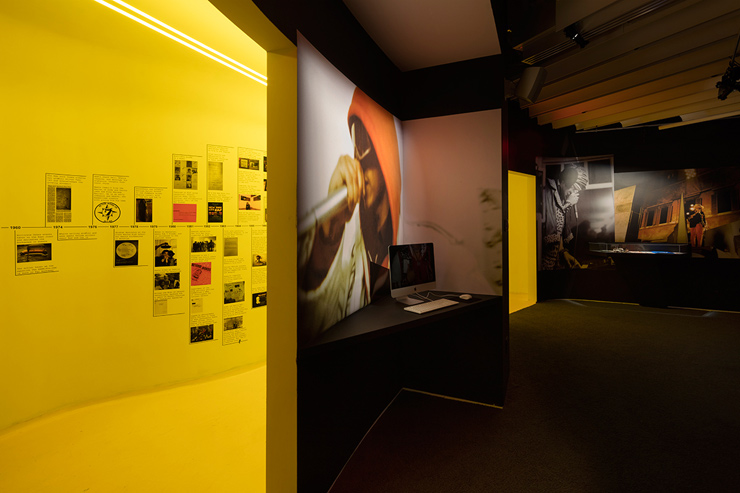
Rammellzee: Racing For Thunder. (photo © Red Bull Arts)
As he passed into his twenties during the early 1980s, Rammellzee was featured in many of the seminal graffiti, hip hop, and fine art events and projects of the times. He worked as an MC with the legendary break dancer Crazy Legs. He was included in shows at significant galleries uptown and downtown in NYC, including Fashion Moda. Basquiat recorded him with K-Rob in one of the first avant-experimental hip hop singles called Beat Bop, in which Rammellzee introduced his “Gangster Duck” nasal vocal style, which later influenced The Beastie Boys’ AdRock and B-Real of Cypress Hill. He also was featured rhyming and performing in Charlie Ahearn’s classic graffiti film Wild Style, as well as playing a cameo in Jim Jarmusch’s first film Stranger Than Paradise. Through the 1980s, as his fame grew within these NYC subcultures, his notoriety also spread around the world, providing him with many opportunities to exhibit and perform in Europe and South America as well.

Rammellzee: Racing For Thunder. (photo © Red Bull Arts)
At the turn of the 1990s, as for most graffiti artists, opportunities plateaued and dropped off, but Rammellzee continued to develop and live as an artist for the next twenty years, until he passed at age 50 in 2010. He dubbed his downtown Manhattan loft space “The Battlestation,” which was where he worked and lived in a creative petri dish of blackened illuminations. During this time period, he discovered new art forms as a writer, performer and sculptor, advancing his original aesthetic theories and styles to create some of his most unique series. He explored other textual formats for his ideas, such as a screenplay called Alpha’s Bet. He continued deeper into his obsession with three-dimensional collage combines, consisting of urban detritus, neon spray paint, and thick resins, making them darker and dirtier, best viewed under ultraviolet blacklight.
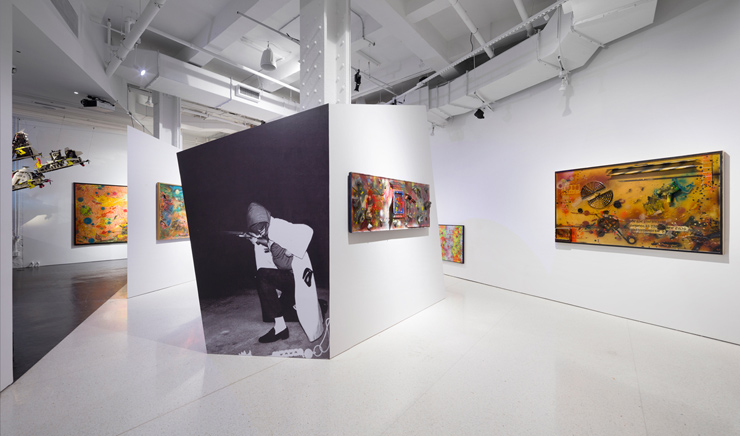
Rammellzee: Racing For Thunder. (photo © Red Bull Arts)
Sculpture became a significant form of expression, as evidenced by his Letter Racer series, which was a physical manifestation of the alphabet with skateboards as their base, designed following the aerodynamic ideals of his Ikonoklast Panzerism theories. Also, his life-size kabuki-transformer costume, which he had begun to construct in the early eighties to wear during his public appearances, schizophrenically mutated into an earthly Asgard of costumed deities dubbed The Garbage Gods, each with a fully conceived personality and narrative. He also explored a menagerie of new characters in the form of figurine-sized plastic sculptures that he called Monster Models. Beyond these Battlestation-based monastic divinations, Rammellzee also continued to explore a spacey hip hop style of music and costumed performance within art and music contexts. He released solo albums and collaborated with many new groups, such as New Flesh, Death Comet Crew, and Praxis.
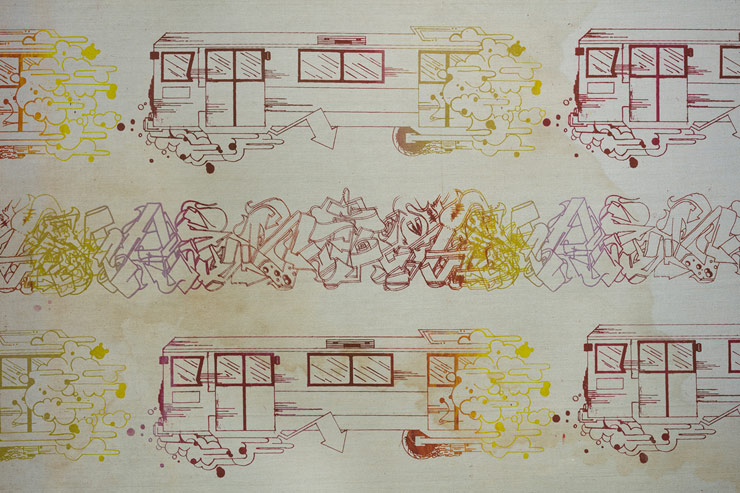
Rammellzee: Racing For Thunder. (photo © Red Bull Arts)
After being such a strong voice and powerful creative force during his lifetime, it is especially sad that he passed away at only fifty years old in 2010. Although on par with Basquiat and Haring in terms of talent and intellect, Rammellzee remained somewhat of an outsider to the fine art world in terms of society, aesthetics, and market. Maybe his work was too rooted in true graffiti styles to appeal to the older moneyed class at that time, who were more interested in expressionism and minimalism. Maybe it was too challenging as a militaristic revolutionary expression, making the agents of the matrix nervous. Maybe it was too dark and quirky like Rammellzee himself. Or, maybe, like so many other visionary autodidact Outsider Artists, his work was just too out there for those to take it all in without quickly dismissing it as merely untrained gibberish. Although too late for Rammellzee himself to appreciate, it is gratifying to see an exhibition like RAMMELLZEE: RACING FOR THUNDER fully present and ultimately confirm Rammellzee’s brilliance, relevance and importance on all levels, in all subcultures, in all mediums, across a half century of promethean artistic creation.
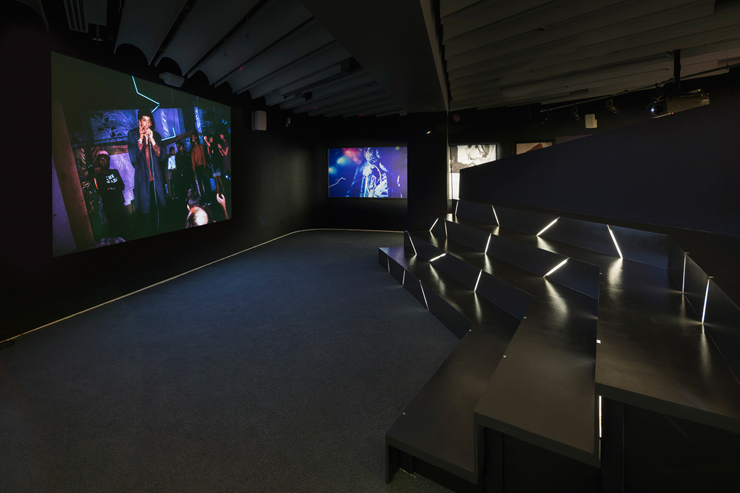
Rammellzee: Racing For Thunder. (photo © Red Bull Arts)
—
Part 2: The Exhibition
In recognition of the breadth and depth of this artist, the RAMMELLZEE: RACING FOR THUNDER retrospective is a deeply researched, insightfully curated, and densely designed exhibition. It is an engaging experience presenting Rammellzee’s complete oeuvre in a two-floor chronological survey, which also contextualizes his output with a massive amount of historical interviews and documentation in all media formats. This is the first exhibition of its kind for Rammellzee, and, depending on one’s age, it may be a once in a lifetime exhibition for us.
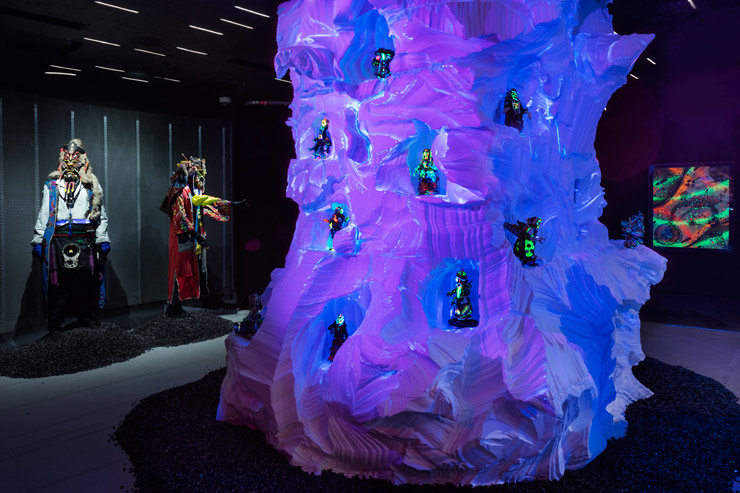
Rammellzee: Racing For Thunder. (photo © Red Bull Arts)
So, if you have the time and the inclination, definitely allot at least an afternoon, if not a few days, in revelry to absorb it all. When many of us first come in contact with Rammellzee’s art and writing, we find it to be an exhilarating, but dizzying, elliptical swirl of crypto-poetic language and visionary ideas, combining concepts from all intellectual disciplines. So, this exhibition gives one a great opportunity to immerse oneself deeply in his world in order to connect the sparkling galactic astronomy of his cosmology and grasp his expansive vision. After reading and rereading his texts; researching his vocabulary and neologisms; becoming familiar with his unique sentence configurations; watching and rewatching his lectures and interviews; viewing and dissecting his art and graphics; then, the beautiful language and pregnant details of his art and philosophy tie together into a comprehensive mytho-ontological diagram of life, science, society, and aesthetics.
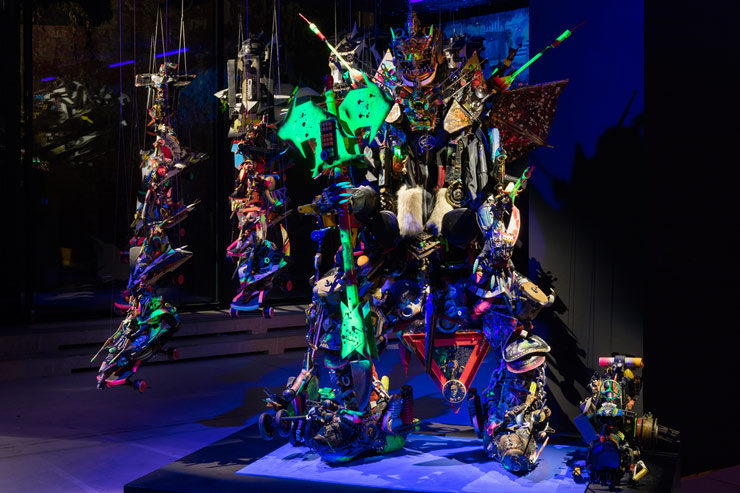
Rammellzee: Racing For Thunder. (photo © Red Bull Arts)
The lead curators Max Wolf and Carlo McCormick have a long history between them within the art world and graffiti communities. They were able to obtain significant paintings and sculptures, printed matter and photographs, videos and audio recordings from friends and collectors around the world in order to fully represent Rammellzee’s polymath output. Maybe most significantly, they also recorded new oral history interviews with friends and collaborators, such as Futura, Keo, Lee, Daze, Jim Jarmusch, Bill Laswell, Charlie Ahearn, Henry Chalfant, K-Rob, and dozens more. From these interviews, they culled short clips which are presented on nine iPads with headphones located throughout exhibition. As you listen, there are also extensive slideshows on the iPads to swipe through.
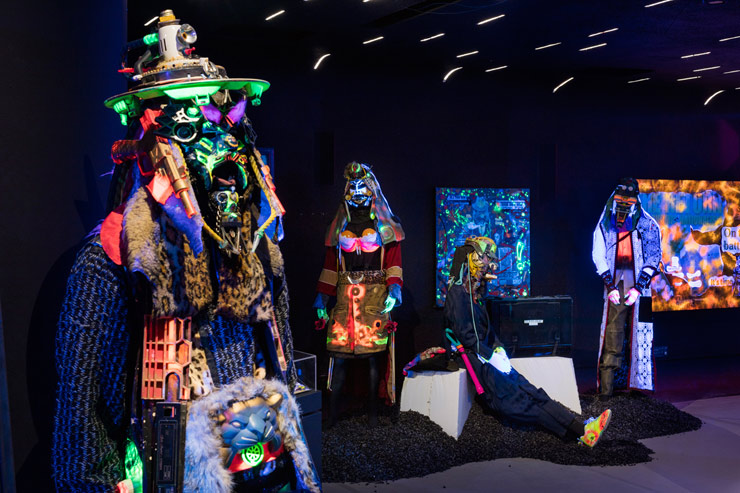
Rammellzee: Racing For Thunder. (photo © Red Bull Arts)
There is never a wasted opportunity to pack some more content into all the nooks and crannies of this exhibition. In addition to the iPads, there are also six video stations, four sound installations, a full-size film-screening theater, and one computer station. In total, there is at least a full day of interviews, performances, lectures, and other historical media to listen to or watch. There are even recordings playing in the bathrooms, and one speaker installed outside in front of the gallery under a sidewalk grate, playing a recording of Rammellzee acting as a subway conductor announcing train arrivals and departures. They also programmed a series of in-person gallery tours and presentations held in the gallery once or twice a week, by artists and historians, such as Carlo McCormick, Kool Koor, Delta2, Crazy Legs, Charlie Ahearn, Seth Tillett, Enrico Oyama Isamu, The Death Comet Crew, and more.
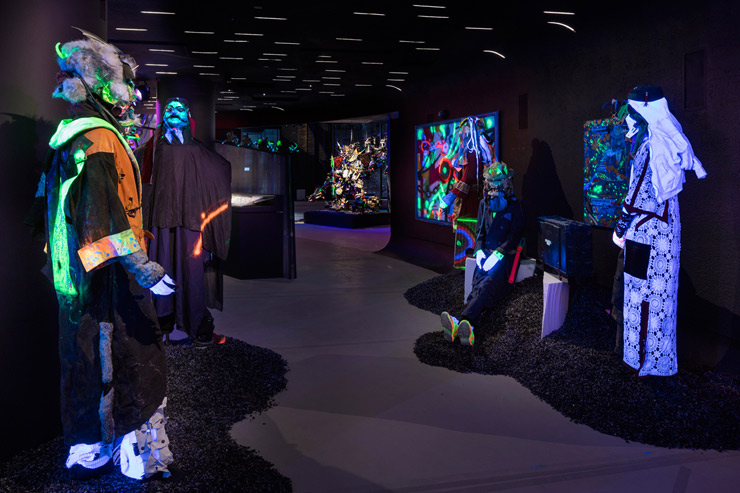
Rammellzee: Racing For Thunder. (photo © Red Bull Arts)
Then to top it off, they designed a free printed exhibition piece available at the front desk. On one side it has a poster of The Garbage Gods pantheon with descriptions; but then it is also folded up to display the other side as an accordion-style zine, consisting of a brilliant introductory essay, specific details about the exhibition, and many crucial outtakes from Rammellzee’s writing. Even if you don’t have time to walk through the exhibition, this pamphlet alone makes the trip to the gallery worthwhile for any fan or scholar because it is such a great piece of historical ephemera to bag-up as a collectible or to use as reference material.
Finally, as the grand denouement to this wonderfully extravagant exhibition, a book-length catalog will be published this fall. So, if you can’t see the exhibition or pick up the zine, this book will be the next best thing.
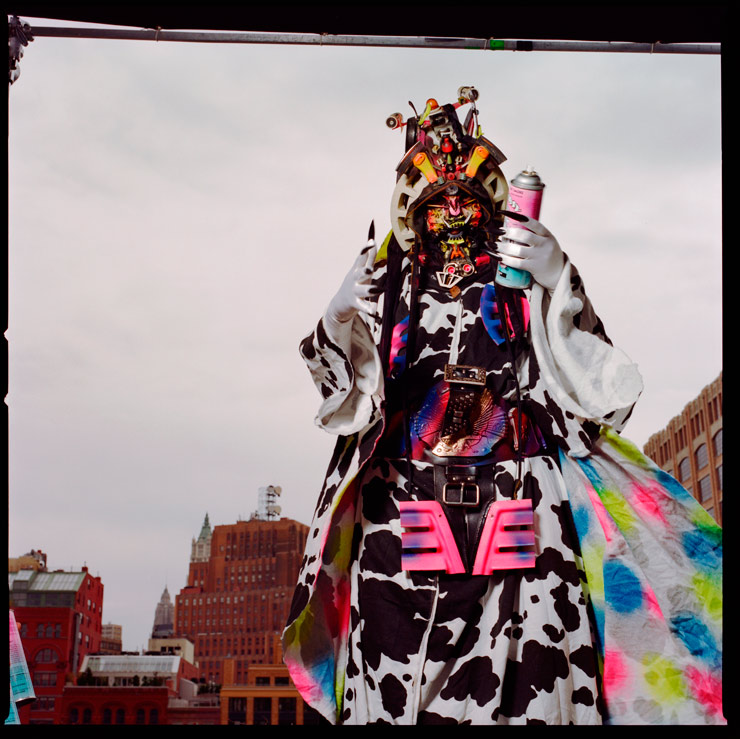
Rammellzee (photo © Keetja Allard. Courtesy of Red Bull Arts)
by ( ( ( ekg ) ) )
July 2018, NYC
Artist page: http://www.concretetodata.com/artists/ekg/
Instagram: @ekglabs
RAMMELLZEE: RACING FOR THUNDER retrospective at the Red Bull Art Space, 220 West 18th Street in Manhattan, through August 26th, Wednesdays thru Sundays, 12pm – 7pm.
 BROOKLYN STREET ART LOVES YOU MORE EVERY DAY
BROOKLYN STREET ART LOVES YOU MORE EVERY DAY










